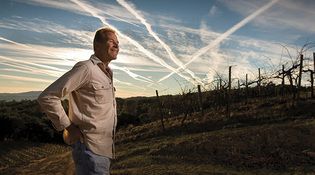 loading
loading
featuresJosh Jensen: pinot pioneerJosh Jensen ’66 was not supposed to be able to produce a great pinot noir in the United States. Let alone in California.  Craig Lee/San Francisco Chronicle/PolarisJosh Jensen ’66. View full imageJosh Jensen ’66 isn’t pleased that it took longer than usual to drive the 100 miles from his home to San Francisco International Airport. Traffic was absurd. “And midday on a weekend. I’m just amazed by it,” he says, shaking his head. He bends his six-foot-three frame into a plastic chair and sets an analog watch on the table to track the time. In a couple of hours, he’ll depart on his annual business trip to Japan, where 30 percent of his vineyard’s production ends up. “I’m one of those wine bores you never want to get stuck next to on a plane. I look over and the poor guy’s fallen asleep,” he says, without the slightest smile. Jensen’s path to wine expertise was clearly fated. Growing up in Orinda, California, he often attended dinner parties with his parents at the house of a friend of theirs. George Selleck was a wine connoisseur with an impressive cellar. “He had me smelling and sipping wine since I was 12,” Jensen says. He majored in history at Yale and then chose to study anthropology at Oxford—partly out of angst. His peers were getting started in their careers. “They all knew what they wanted to do,” he says. “And I had no idea. No idea.” Following Selleck’s advice, after graduating from Oxford he began exploring wineries throughout Europe. In Burgundy, he sought out the legendary estate Domaine de la Romanée-Conti, in a historic region where the only red wine produced is pinot noir, and asked to apprentice there. Jensen pantomimes knocking on the door of the winery, eyes bulging with insecurity. “October 1st, 1970,” he says. “Harvest took ten days.” He picked grapes. He stomped them with his bare feet. He translated for cellar master Andre Noblet to English importers. And he fell in love with pinot noir. With no winemaking or business experience, Jensen returned to California in 1971 determined to find the limestone that wine makers in Burgundy convinced him was essential for a great pinot noir. Popular belief at the time was that the United States simply could not produce a great pinot noir. Definitely not California—it was too hot, among other things. Did Jensen set out strictly to prove them wrong? “Yeah,” he says, matter-of-factly. His parents and a family friend invested in the venture. He studied geologic maps from the state Bureau of Mines. The geologists were amused by his ambition, and doubtful he’d find any limestone. But after two years of searching up and down the state, he moved his then-wife (they are divorced) and the first of his three children into a mobile home and began planting 22 acres of pinot noir on Mount Harlan, atop several million tons of limestone deposit. He named it Calera, Spanish for limekiln. It is one of only two vineyards in the state to produce pinot noir on limestone-derived soil. There are still no paved roads, electricity, or telephone lines up on the mountain. The only water sources are rainfall and a few wells. Less water means a lower yield, which Jensen says makes the flavor of his wines all the more intense. In 2007, Jensen won the biggest US wine honor, the San Francisco Chronicle’s Winemaker of the Year Award. His wine is admired internationally for its authenticity and complexity. He lives now in the rustic home he built in 1979, 100 feet from the winery buildings and a half-hour drive from Calera’s nine planted vineyards. Six of the vineyards are pinot noirs, including one named Selleck.
The comment period has expired.
|
|